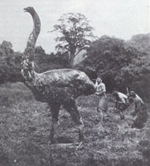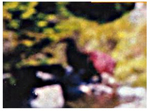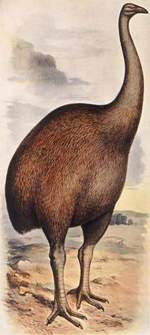
The Moa were large flightless birds which once roamed New Zealand and are thought to have gone extinct sometime in the 1500’s, although some reports speculate that a few specimens may have persisted in remote corners of New Zealand up until the 18th and possibly 19th centuries. Moa were the dominant herbivores in the New Zealand forest ecosystem with the females growing larger than the males and the largest specimen reaching 12 feet in height and weighing roughly 550 pounds.  The extinction of the Moa is attributed to over hunting and forest clearing by the Maori, the indigenous people of New Zealand. Moa where also hunted by Haast’s Eagle, the world’s largest eagle also now extinct, possibly due to lack the lack of a food source as large as the Moa. When European settlers arrived in New Zealand the indigenous Maori told tales of a huge bird known to them as the Moa, which had once roamed the flats and valleys, however these first European settlers of New Zealand showed little interest in the physical evidence presented to them.
The extinction of the Moa is attributed to over hunting and forest clearing by the Maori, the indigenous people of New Zealand. Moa where also hunted by Haast’s Eagle, the world’s largest eagle also now extinct, possibly due to lack the lack of a food source as large as the Moa. When European settlers arrived in New Zealand the indigenous Maori told tales of a huge bird known to them as the Moa, which had once roamed the flats and valleys, however these first European settlers of New Zealand showed little interest in the physical evidence presented to them.
In 1839, Poverty Bay flax trader, and natural history enthusiast, John W. Harns was given a piece of unusual bone by a Maori who found it in a river bank. Harns brought the 6 inch long bone fragment to his uncle, John Rule, a Sydney surgeon, who then sent the fragment to Richard Owen who at the time was working at the Hunterian Museum at the Royal College of Surgeons in London. After puzzling over the bone fragment for nearly 4 years Owens established that it was part of a femur which belonged to a large animal.
Owen noted that the bone was oddly light and honeycombed and would later announce to a skeptical scientific community that the bone was from a giant extinct bird similar to an ostrich. Initially met with ridicule his theory was proven correct by the subsequent discovery of a considerable quantity of Moa bones throughout New Zealand. In 2004, the National History Museum in London placed the Moa bone fragment Owen had first examined on display.  In his 1958 book One the Track of Unknown Animals, Bernard Heuvelmans titled a chapter The Moa, a Fossil That May Still Thrive which described rare sightings of the Moa that have been reported periodically in New Zealand since their supposed extinction five hundred years ago. Also, In the 1960’s Ivan T. Sanderson took note of continuing, though rare, sightings of Moa on New Zealand’s South Island.
In his 1958 book One the Track of Unknown Animals, Bernard Heuvelmans titled a chapter The Moa, a Fossil That May Still Thrive which described rare sightings of the Moa that have been reported periodically in New Zealand since their supposed extinction five hundred years ago. Also, In the 1960’s Ivan T. Sanderson took note of continuing, though rare, sightings of Moa on New Zealand’s South Island.
The most recent alleged sightings of a Moa occurred on January 20, 1993, in the Craigieburn Range of New Zealand when hotel owner and former instructor with the British Army’s elite Special Air Services Paddy Freaney, and his companions Sam Waby and Rochelle Rafferly sighted and photographed what they insisted was a 6 foot tall Moa. The three men where Tramping, a New Zealand term for hiking in rugged terrain, when they claimed to have come across a large bird, Freaney would later state that the minute he saw the creature he knew it was a Moa.
They claimed that the creature they saw stood about 3 feet off the ground and had a thin, long neck, of another 3 feet, ending in a small head and beak. The bird had reddish brown and grey feathers that covered its entire body with the exception of its legs below the knees, a feature Heuvelmans later supported by stating that there was no evidence that the Moa did not have feathered legs.  Seeing the three men the Moa took off across a steam, Freaney, an outdoor survival expert with the SAS, gave chase and was able to take a photograph of the Moa at a distance of nearly 115 feet. He also snapped a picture of what he thought was the bird’s footprints on a rock and of a similar print in the river bed. The resulting out of focus picture appears to show a large, medium brown bird with a horizontal body, a tall, erect neck and a head that may have been looking toward the camera, a clear view of the creatures legs is obstructed by a rock formation.
Seeing the three men the Moa took off across a steam, Freaney, an outdoor survival expert with the SAS, gave chase and was able to take a photograph of the Moa at a distance of nearly 115 feet. He also snapped a picture of what he thought was the bird’s footprints on a rock and of a similar print in the river bed. The resulting out of focus picture appears to show a large, medium brown bird with a horizontal body, a tall, erect neck and a head that may have been looking toward the camera, a clear view of the creatures legs is obstructed by a rock formation.
The photo was given to an image processing group at the University of Canterbury’s electrical and electronic engineering department for review. After studying the blurry photograph for 3 days Kevin Taylor, spokesperson for the group, announced that the analysis had gone as far as it could and, in the groups opinion, the object in the photo did appear to be a large bird. The success of this ruling did not last long however as former University of Canterbury postgraduate zoology student Richard Holdaway announced that after he studied the photograph he was able to determine that the object was nothing more than a red deer, stating that the neck was to thick to belong to a bird.
As a result the Department of Conservation backed away from its announced plan to search the area, Freaney offered to mount an expedition himself, if nothing else to clear his name after rumors that he hoaxed the photo began to circulate, but his offer was declined and the damage was done. Weeks after Freaney’s sighting bad weather in the back country all but eliminated the proof of his Moa encounter, especially the footprints in the river bank.
On February 22, 1993 Freaney was interviewed by renowned Cryptozoologist Loren Colemen to clarify some points of the report. Freaney stated that he had turned over the original negatives for analysis, but results of that examination proved inconclusive. Freaney also stated that the bird was definitely larger than any emu he had ever seen in Australia and that the light brown feathers appeared to stop at the knees.
In the mid 1990’s, after growing expert attempts at debunking his account and suggestions by Karl Shuker and Strange Magazine editor Mark Chorvinsky that his sighting was a hoax, Freaney organized several mini expeditions in an attempt to capture a live specimen of Moa and stop the slander of his name. These expeditions failed to capture a Moa and no new sightings where reported by the team, however, though extremely rare, sightings of the Moa, or at least an animal eyewitness claim to be a Moa, continue to be reported to this day.
The Evidence
To date no physical evidence exists that would suggest that the Moa may still roam New Zealand.
The Sightings
On January 20, 1993, in the Craigieburn Range of New Zealand, Paddy Freaney, hotel owner and former instructor with the British Army’s elite Special Air Services, and his companions Sam Waby and Rochelle Rafferly sighted and photographed what they insisted was a 6 foot tall Moa.
In 1993, according to Loren Coleman’s book, Cryptozoology A to Z, two German trekkers in New Zealand recorded a Moa sighting in a hiking outpost logbook. German Cryptozoologist Ulrich Magin confirmed that the two Germans had been in New Zealand at the time of the reported sighting, however he suspected that a hoaxer had simply appropriated their names.
The Stats – (Where applicable)
• Classification: Hybrid / Other
• Size: Roughly 6 feet tall
• Weight: Unknown
• Diet: Herbivore
• Location: New Zealand
• Movement: Two legged walking
• Environment: Forest
|